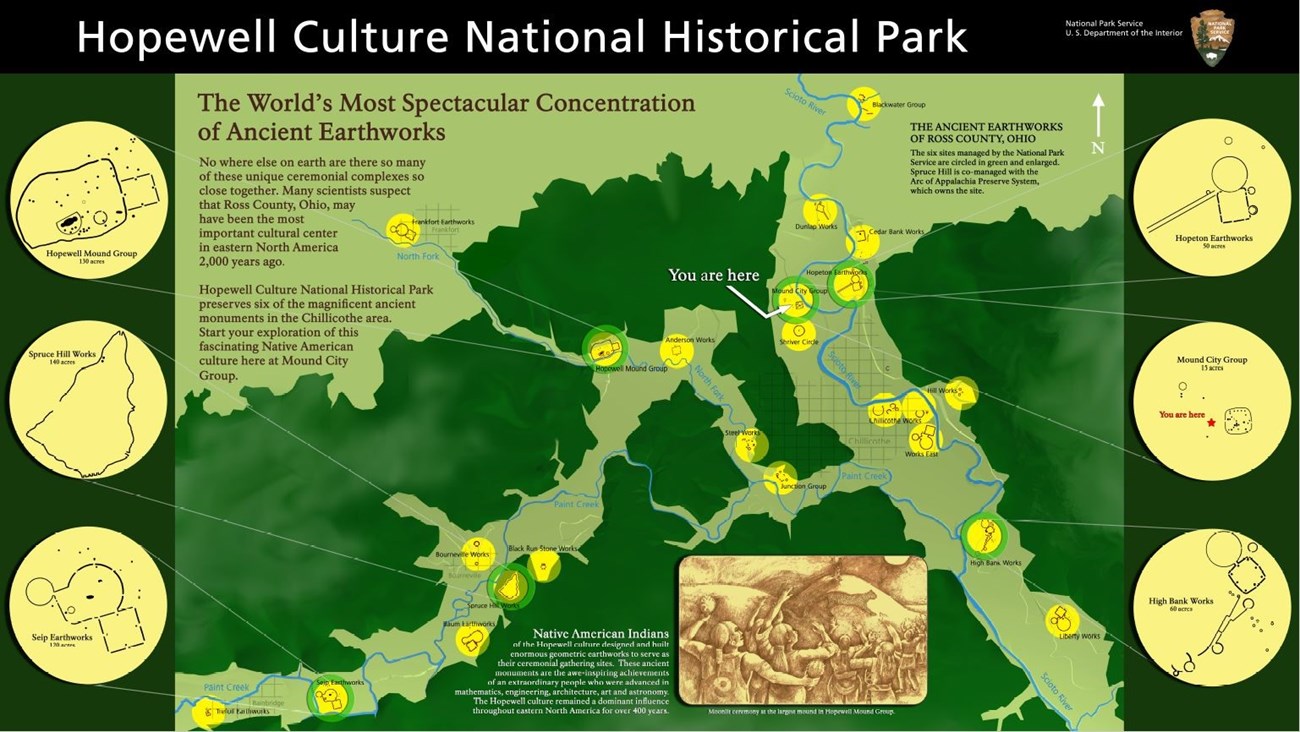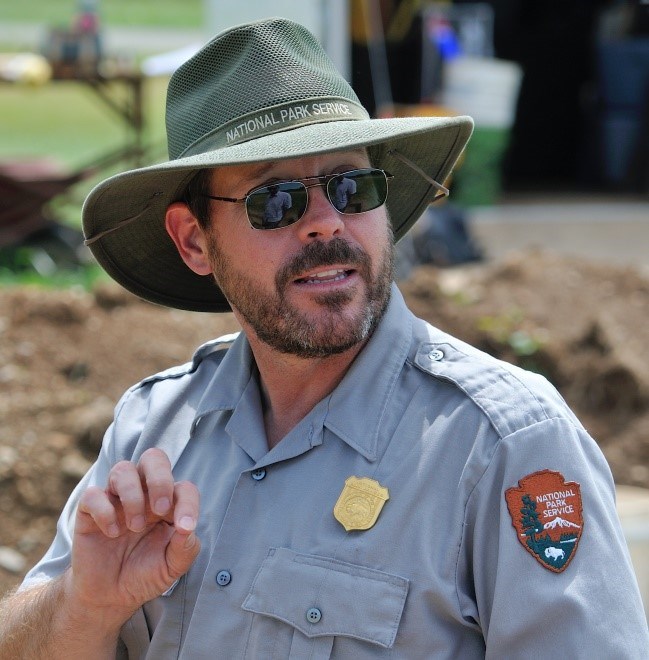Last updated: June 30, 2021
Article
Ohio's National Park Sites in Ross County Contribute to World Heritage
Bret J. Ruby, PhD
Park Archeologist and Chief of Resource Management at Hopewell Culture National Historical Park
A version of this article was published in the Newark Advocate on January 20, 2021.
Park Archeologist and Chief of Resource Management at Hopewell Culture National Historical Park
A version of this article was published in the Newark Advocate on January 20, 2021.
The ongoing effort to nominate “Hopewell Ceremonial Earthworks” to the World Heritage List includes eight ancient American Indian earthwork complexes: the Octagon Earthworks and Great Circle in Licking County; the Fort Ancient Earthworks in Warren County; and five earthworks included in Hopewell Culture National Historical Park in Ross County, Ohio. The National Park Service sites near Chillicothe make some special contributions to the overall nomination. The earthworks in Ross County can be considered the center, or heartland of the Hopewell phenomenon. The earthworks found there have a long history of study that continues to this day, and much of what we know about Hopewell was learned in this area. The earthworks in the Chillicothe area have been a focus for tourism, recreation, research, and education for more than 100 years, and World Heritage listing will increase these opportunities.
Archaeologists recognize the region surrounding the confluence of the Scioto River and Paint Creek in Ross County, Ohio as the “Hopewell core.” Nowhere else in the world can one find such a spectacular concentration of Hopewell geometric earthworks. More than two dozen of the largest earthwork enclosures are found within 30 miles of Chillicothe, along with most of the largest Hopewell mounds. The Indigenous people who built these sites are justly famous for the beautiful and finely crafted sacred objects they made and used at the earthworks. Many of these were fashioned from exotic raw materials obtained from distant parts of North America, including copper from the Great Lakes, marine shell from the Gulf of Mexico, and obsidian from Yellowstone National Park. Most of these artistic masterpieces were deposited at the earthwork sites now included in Hopewell Culture National Historical Park (NHP).
Some of the earliest scientific attempts to understand “Who built these earthworks?” and “Why?” were made at these Ross County sites. Two Chillicothe residents—Ephraim Squier and Edwin Davis—carefully measured and mapped the most impressive earthworks surrounding their homes in the 1840s. They excavated dozens of mounds. Their efforts to carefully record and publish their findings set them apart from unscientific “relic hunters.” Some of their most important discoveries were made at the Mound City Group earthworks, now the centerpiece of Hopewell Culture NHP. Here they found tobacco smoking pipes, masterfully carved into realistic images of birds, mammals, and amphibians. Tobacco continues to be smoked as a sacrament in American Indian religious ceremonies today. The Mound City pipes were burned and broken, and deposited on carefully prepared clay altars. These were among the first clues that what we call “Hopewell” is a set of religious beliefs and practices expressed in sacred objects and earthworks: an American Indian religious movement that spread across many distinct cultures and half the continent, nearly 2000 years ago. Research to understand and appreciate the minds and motivations of these Indigenous peoples continues today.
These early discoveries led directly to the establishment of Mound City Group National Monument in 1923. In 1992, the park was expanded with the addition of Hopeton Earthworks, High Bank Works, Seip Earthworks, and the Hopewell Mound Group, and renamed as Hopewell Culture National Historical Park. Designation as a World Heritage Site will expand our ability to meet our original mission to preserve, protect, and educate the world about the human creative genius embodied in this American Indian heritage.
Archaeologists recognize the region surrounding the confluence of the Scioto River and Paint Creek in Ross County, Ohio as the “Hopewell core.” Nowhere else in the world can one find such a spectacular concentration of Hopewell geometric earthworks. More than two dozen of the largest earthwork enclosures are found within 30 miles of Chillicothe, along with most of the largest Hopewell mounds. The Indigenous people who built these sites are justly famous for the beautiful and finely crafted sacred objects they made and used at the earthworks. Many of these were fashioned from exotic raw materials obtained from distant parts of North America, including copper from the Great Lakes, marine shell from the Gulf of Mexico, and obsidian from Yellowstone National Park. Most of these artistic masterpieces were deposited at the earthwork sites now included in Hopewell Culture National Historical Park (NHP).
Some of the earliest scientific attempts to understand “Who built these earthworks?” and “Why?” were made at these Ross County sites. Two Chillicothe residents—Ephraim Squier and Edwin Davis—carefully measured and mapped the most impressive earthworks surrounding their homes in the 1840s. They excavated dozens of mounds. Their efforts to carefully record and publish their findings set them apart from unscientific “relic hunters.” Some of their most important discoveries were made at the Mound City Group earthworks, now the centerpiece of Hopewell Culture NHP. Here they found tobacco smoking pipes, masterfully carved into realistic images of birds, mammals, and amphibians. Tobacco continues to be smoked as a sacrament in American Indian religious ceremonies today. The Mound City pipes were burned and broken, and deposited on carefully prepared clay altars. These were among the first clues that what we call “Hopewell” is a set of religious beliefs and practices expressed in sacred objects and earthworks: an American Indian religious movement that spread across many distinct cultures and half the continent, nearly 2000 years ago. Research to understand and appreciate the minds and motivations of these Indigenous peoples continues today.
These early discoveries led directly to the establishment of Mound City Group National Monument in 1923. In 1992, the park was expanded with the addition of Hopeton Earthworks, High Bank Works, Seip Earthworks, and the Hopewell Mound Group, and renamed as Hopewell Culture National Historical Park. Designation as a World Heritage Site will expand our ability to meet our original mission to preserve, protect, and educate the world about the human creative genius embodied in this American Indian heritage.

NPS image

Photo credit: Timothy E. Black
